Managing Innovation Report: Brewdog, Innovation and Future Development
VerifiedAdded on 2022/09/09
|14
|4000
|17
Report
AI Summary
This report examines Brewdog's innovation strategies through the lens of the Blue Ocean Innovation theory. It begins with an introduction to the theory, defining its principles and processes, and evaluating its benefits and limitations. The report then applies the theory to Brewdog's historical development, providing background information on the company and analyzing its business models. It explores how Brewdog has utilized the Blue Ocean Strategy to redefine the British beer industry. Finally, the report speculates on the future development of Brewdog, recommending potential pathways for continued innovation and market expansion based on the principles of the Blue Ocean Innovation theory. The analysis covers Brewdog's growth, strategic decisions, and the application of the theory in both historical and potential future contexts, including its international expansion and community-driven initiatives.

Managing innovation
Paraphrase This Document
Need a fresh take? Get an instant paraphrase of this document with our AI Paraphraser

Managing Innovation 1
Contents
Introduction...........................................................................................................................................2
Blue Ocean Innovation theory...............................................................................................................2
Application of the Blue Ocean innovation theory in the historical development context......................6
Application of Blue Ocean innovation theory in the future context.......................................................7
Conclusion.............................................................................................................................................8
Bibliography........................................................................................................................................10
Appendix.............................................................................................................................................13
Contents
Introduction...........................................................................................................................................2
Blue Ocean Innovation theory...............................................................................................................2
Application of the Blue Ocean innovation theory in the historical development context......................6
Application of Blue Ocean innovation theory in the future context.......................................................7
Conclusion.............................................................................................................................................8
Bibliography........................................................................................................................................10
Appendix.............................................................................................................................................13
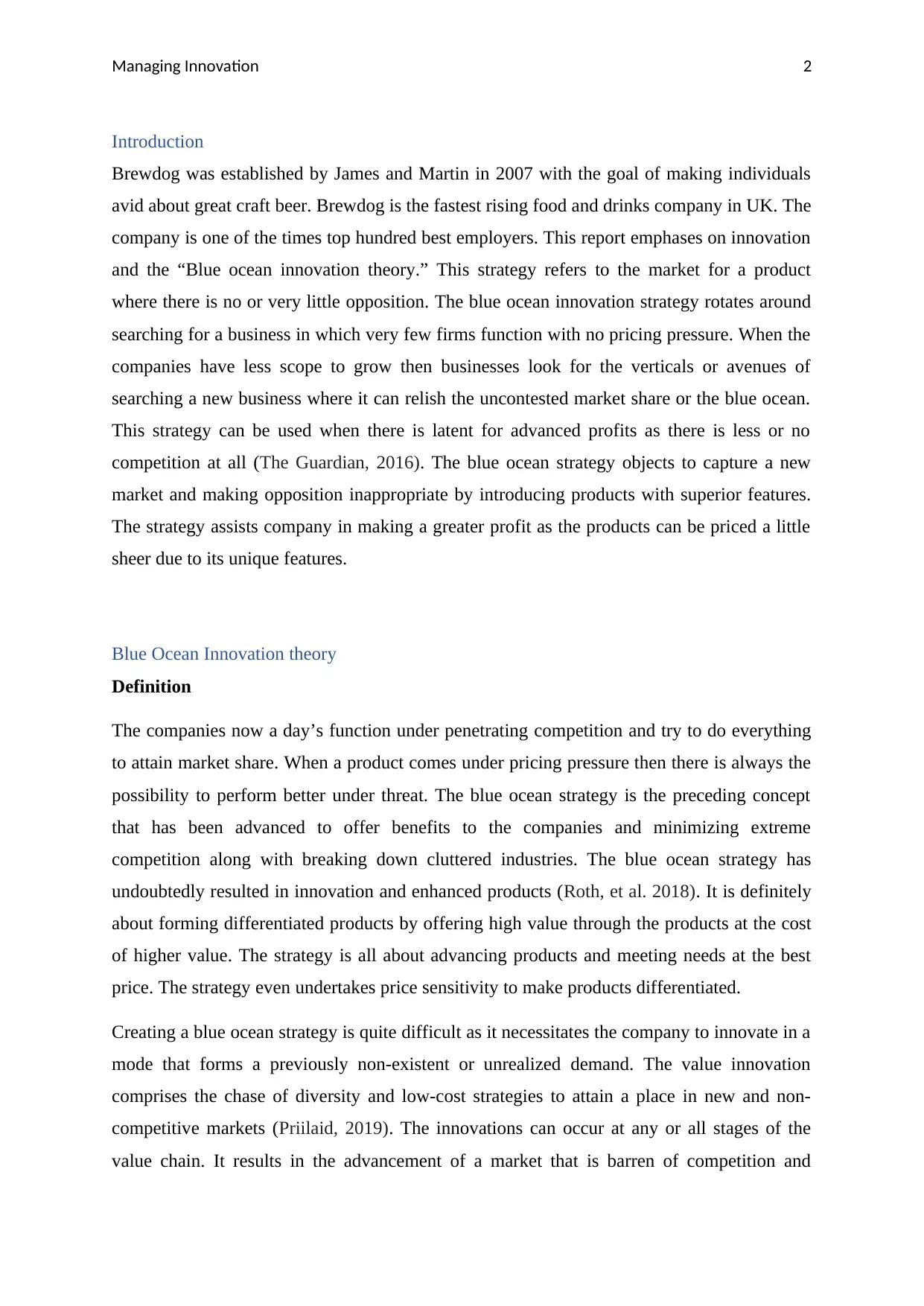
Managing Innovation 2
Introduction
Brewdog was established by James and Martin in 2007 with the goal of making individuals
avid about great craft beer. Brewdog is the fastest rising food and drinks company in UK. The
company is one of the times top hundred best employers. This report emphases on innovation
and the “Blue ocean innovation theory.” This strategy refers to the market for a product
where there is no or very little opposition. The blue ocean innovation strategy rotates around
searching for a business in which very few firms function with no pricing pressure. When the
companies have less scope to grow then businesses look for the verticals or avenues of
searching a new business where it can relish the uncontested market share or the blue ocean.
This strategy can be used when there is latent for advanced profits as there is less or no
competition at all (The Guardian, 2016). The blue ocean strategy objects to capture a new
market and making opposition inappropriate by introducing products with superior features.
The strategy assists company in making a greater profit as the products can be priced a little
sheer due to its unique features.
Blue Ocean Innovation theory
Definition
The companies now a day’s function under penetrating competition and try to do everything
to attain market share. When a product comes under pricing pressure then there is always the
possibility to perform better under threat. The blue ocean strategy is the preceding concept
that has been advanced to offer benefits to the companies and minimizing extreme
competition along with breaking down cluttered industries. The blue ocean strategy has
undoubtedly resulted in innovation and enhanced products (Roth, et al. 2018). It is definitely
about forming differentiated products by offering high value through the products at the cost
of higher value. The strategy is all about advancing products and meeting needs at the best
price. The strategy even undertakes price sensitivity to make products differentiated.
Creating a blue ocean strategy is quite difficult as it necessitates the company to innovate in a
mode that forms a previously non-existent or unrealized demand. The value innovation
comprises the chase of diversity and low-cost strategies to attain a place in new and non-
competitive markets (Priilaid, 2019). The innovations can occur at any or all stages of the
value chain. It results in the advancement of a market that is barren of competition and
Introduction
Brewdog was established by James and Martin in 2007 with the goal of making individuals
avid about great craft beer. Brewdog is the fastest rising food and drinks company in UK. The
company is one of the times top hundred best employers. This report emphases on innovation
and the “Blue ocean innovation theory.” This strategy refers to the market for a product
where there is no or very little opposition. The blue ocean innovation strategy rotates around
searching for a business in which very few firms function with no pricing pressure. When the
companies have less scope to grow then businesses look for the verticals or avenues of
searching a new business where it can relish the uncontested market share or the blue ocean.
This strategy can be used when there is latent for advanced profits as there is less or no
competition at all (The Guardian, 2016). The blue ocean strategy objects to capture a new
market and making opposition inappropriate by introducing products with superior features.
The strategy assists company in making a greater profit as the products can be priced a little
sheer due to its unique features.
Blue Ocean Innovation theory
Definition
The companies now a day’s function under penetrating competition and try to do everything
to attain market share. When a product comes under pricing pressure then there is always the
possibility to perform better under threat. The blue ocean strategy is the preceding concept
that has been advanced to offer benefits to the companies and minimizing extreme
competition along with breaking down cluttered industries. The blue ocean strategy has
undoubtedly resulted in innovation and enhanced products (Roth, et al. 2018). It is definitely
about forming differentiated products by offering high value through the products at the cost
of higher value. The strategy is all about advancing products and meeting needs at the best
price. The strategy even undertakes price sensitivity to make products differentiated.
Creating a blue ocean strategy is quite difficult as it necessitates the company to innovate in a
mode that forms a previously non-existent or unrealized demand. The value innovation
comprises the chase of diversity and low-cost strategies to attain a place in new and non-
competitive markets (Priilaid, 2019). The innovations can occur at any or all stages of the
value chain. It results in the advancement of a market that is barren of competition and
⊘ This is a preview!⊘
Do you want full access?
Subscribe today to unlock all pages.

Trusted by 1+ million students worldwide
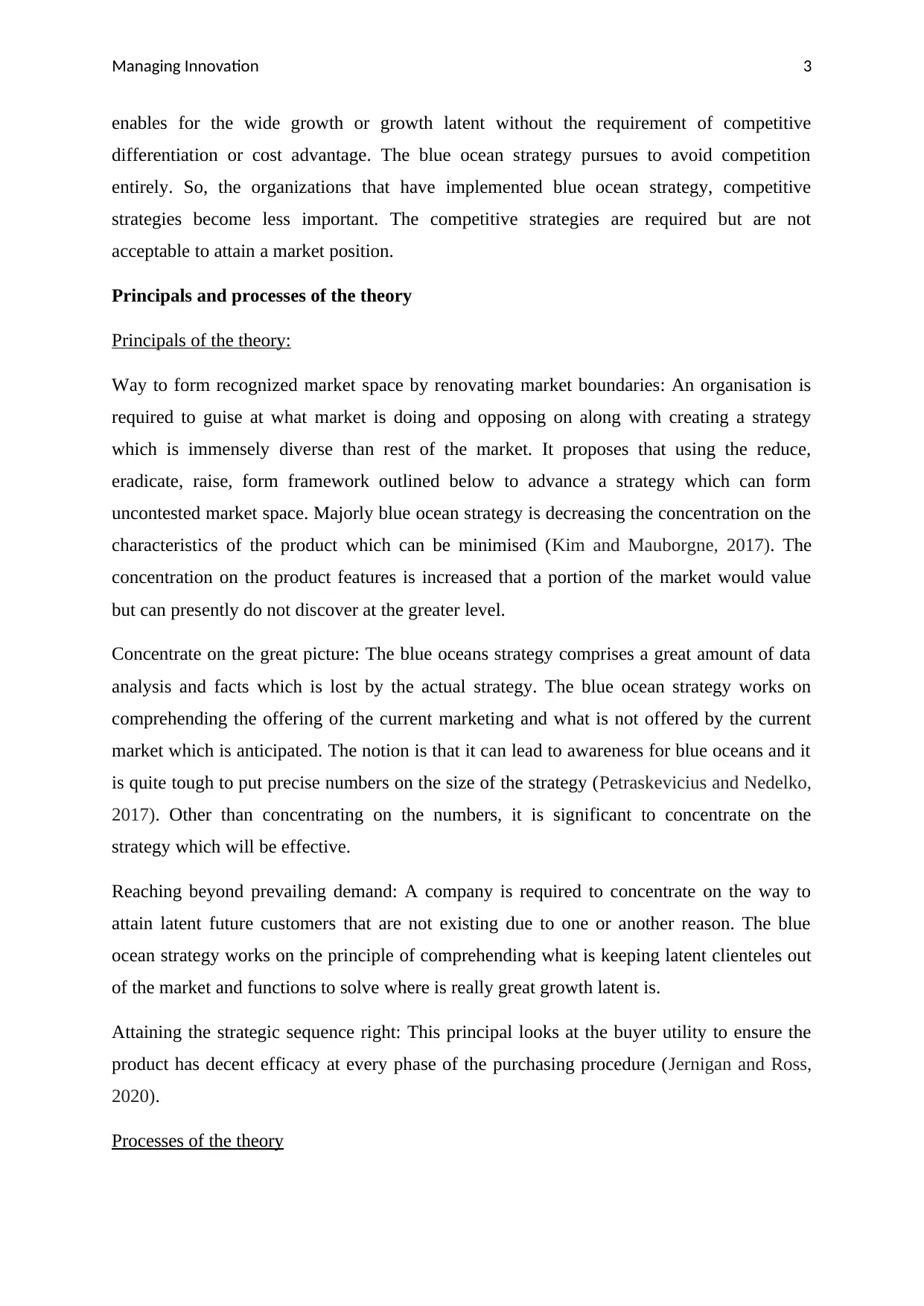
Managing Innovation 3
enables for the wide growth or growth latent without the requirement of competitive
differentiation or cost advantage. The blue ocean strategy pursues to avoid competition
entirely. So, the organizations that have implemented blue ocean strategy, competitive
strategies become less important. The competitive strategies are required but are not
acceptable to attain a market position.
Principals and processes of the theory
Principals of the theory:
Way to form recognized market space by renovating market boundaries: An organisation is
required to guise at what market is doing and opposing on along with creating a strategy
which is immensely diverse than rest of the market. It proposes that using the reduce,
eradicate, raise, form framework outlined below to advance a strategy which can form
uncontested market space. Majorly blue ocean strategy is decreasing the concentration on the
characteristics of the product which can be minimised (Kim and Mauborgne, 2017). The
concentration on the product features is increased that a portion of the market would value
but can presently do not discover at the greater level.
Concentrate on the great picture: The blue oceans strategy comprises a great amount of data
analysis and facts which is lost by the actual strategy. The blue ocean strategy works on
comprehending the offering of the current marketing and what is not offered by the current
market which is anticipated. The notion is that it can lead to awareness for blue oceans and it
is quite tough to put precise numbers on the size of the strategy (Petraskevicius and Nedelko,
2017). Other than concentrating on the numbers, it is significant to concentrate on the
strategy which will be effective.
Reaching beyond prevailing demand: A company is required to concentrate on the way to
attain latent future customers that are not existing due to one or another reason. The blue
ocean strategy works on the principle of comprehending what is keeping latent clienteles out
of the market and functions to solve where is really great growth latent is.
Attaining the strategic sequence right: This principal looks at the buyer utility to ensure the
product has decent efficacy at every phase of the purchasing procedure (Jernigan and Ross,
2020).
Processes of the theory
enables for the wide growth or growth latent without the requirement of competitive
differentiation or cost advantage. The blue ocean strategy pursues to avoid competition
entirely. So, the organizations that have implemented blue ocean strategy, competitive
strategies become less important. The competitive strategies are required but are not
acceptable to attain a market position.
Principals and processes of the theory
Principals of the theory:
Way to form recognized market space by renovating market boundaries: An organisation is
required to guise at what market is doing and opposing on along with creating a strategy
which is immensely diverse than rest of the market. It proposes that using the reduce,
eradicate, raise, form framework outlined below to advance a strategy which can form
uncontested market space. Majorly blue ocean strategy is decreasing the concentration on the
characteristics of the product which can be minimised (Kim and Mauborgne, 2017). The
concentration on the product features is increased that a portion of the market would value
but can presently do not discover at the greater level.
Concentrate on the great picture: The blue oceans strategy comprises a great amount of data
analysis and facts which is lost by the actual strategy. The blue ocean strategy works on
comprehending the offering of the current marketing and what is not offered by the current
market which is anticipated. The notion is that it can lead to awareness for blue oceans and it
is quite tough to put precise numbers on the size of the strategy (Petraskevicius and Nedelko,
2017). Other than concentrating on the numbers, it is significant to concentrate on the
strategy which will be effective.
Reaching beyond prevailing demand: A company is required to concentrate on the way to
attain latent future customers that are not existing due to one or another reason. The blue
ocean strategy works on the principle of comprehending what is keeping latent clienteles out
of the market and functions to solve where is really great growth latent is.
Attaining the strategic sequence right: This principal looks at the buyer utility to ensure the
product has decent efficacy at every phase of the purchasing procedure (Jernigan and Ross,
2020).
Processes of the theory
Paraphrase This Document
Need a fresh take? Get an instant paraphrase of this document with our AI Paraphraser
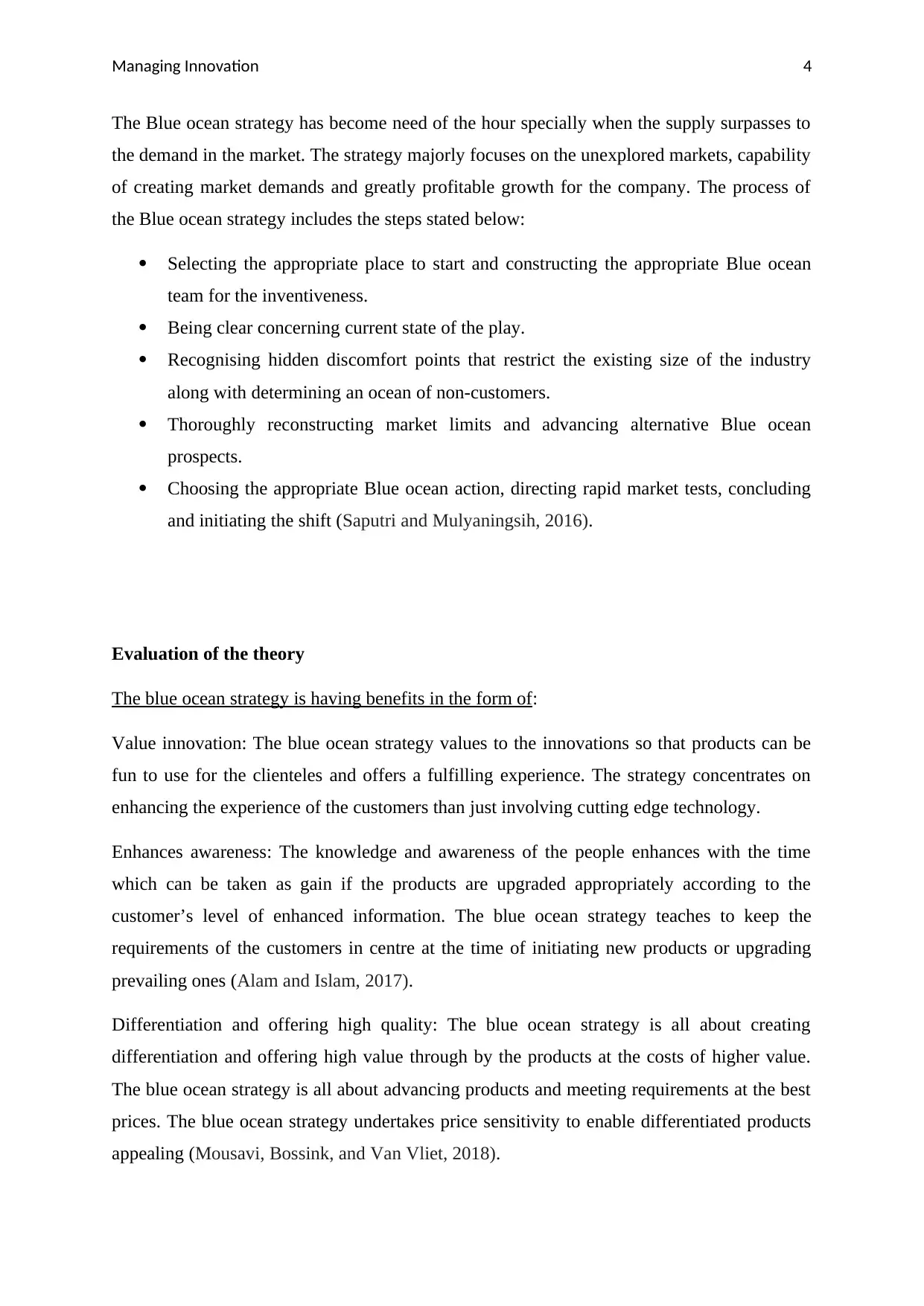
Managing Innovation 4
The Blue ocean strategy has become need of the hour specially when the supply surpasses to
the demand in the market. The strategy majorly focuses on the unexplored markets, capability
of creating market demands and greatly profitable growth for the company. The process of
the Blue ocean strategy includes the steps stated below:
Selecting the appropriate place to start and constructing the appropriate Blue ocean
team for the inventiveness.
Being clear concerning current state of the play.
Recognising hidden discomfort points that restrict the existing size of the industry
along with determining an ocean of non-customers.
Thoroughly reconstructing market limits and advancing alternative Blue ocean
prospects.
Choosing the appropriate Blue ocean action, directing rapid market tests, concluding
and initiating the shift (Saputri and Mulyaningsih, 2016).
Evaluation of the theory
The blue ocean strategy is having benefits in the form of:
Value innovation: The blue ocean strategy values to the innovations so that products can be
fun to use for the clienteles and offers a fulfilling experience. The strategy concentrates on
enhancing the experience of the customers than just involving cutting edge technology.
Enhances awareness: The knowledge and awareness of the people enhances with the time
which can be taken as gain if the products are upgraded appropriately according to the
customer’s level of enhanced information. The blue ocean strategy teaches to keep the
requirements of the customers in centre at the time of initiating new products or upgrading
prevailing ones (Alam and Islam, 2017).
Differentiation and offering high quality: The blue ocean strategy is all about creating
differentiation and offering high value through by the products at the costs of higher value.
The blue ocean strategy is all about advancing products and meeting requirements at the best
prices. The blue ocean strategy undertakes price sensitivity to enable differentiated products
appealing (Mousavi, Bossink, and Van Vliet, 2018).
The Blue ocean strategy has become need of the hour specially when the supply surpasses to
the demand in the market. The strategy majorly focuses on the unexplored markets, capability
of creating market demands and greatly profitable growth for the company. The process of
the Blue ocean strategy includes the steps stated below:
Selecting the appropriate place to start and constructing the appropriate Blue ocean
team for the inventiveness.
Being clear concerning current state of the play.
Recognising hidden discomfort points that restrict the existing size of the industry
along with determining an ocean of non-customers.
Thoroughly reconstructing market limits and advancing alternative Blue ocean
prospects.
Choosing the appropriate Blue ocean action, directing rapid market tests, concluding
and initiating the shift (Saputri and Mulyaningsih, 2016).
Evaluation of the theory
The blue ocean strategy is having benefits in the form of:
Value innovation: The blue ocean strategy values to the innovations so that products can be
fun to use for the clienteles and offers a fulfilling experience. The strategy concentrates on
enhancing the experience of the customers than just involving cutting edge technology.
Enhances awareness: The knowledge and awareness of the people enhances with the time
which can be taken as gain if the products are upgraded appropriately according to the
customer’s level of enhanced information. The blue ocean strategy teaches to keep the
requirements of the customers in centre at the time of initiating new products or upgrading
prevailing ones (Alam and Islam, 2017).
Differentiation and offering high quality: The blue ocean strategy is all about creating
differentiation and offering high value through by the products at the costs of higher value.
The blue ocean strategy is all about advancing products and meeting requirements at the best
prices. The blue ocean strategy undertakes price sensitivity to enable differentiated products
appealing (Mousavi, Bossink, and Van Vliet, 2018).
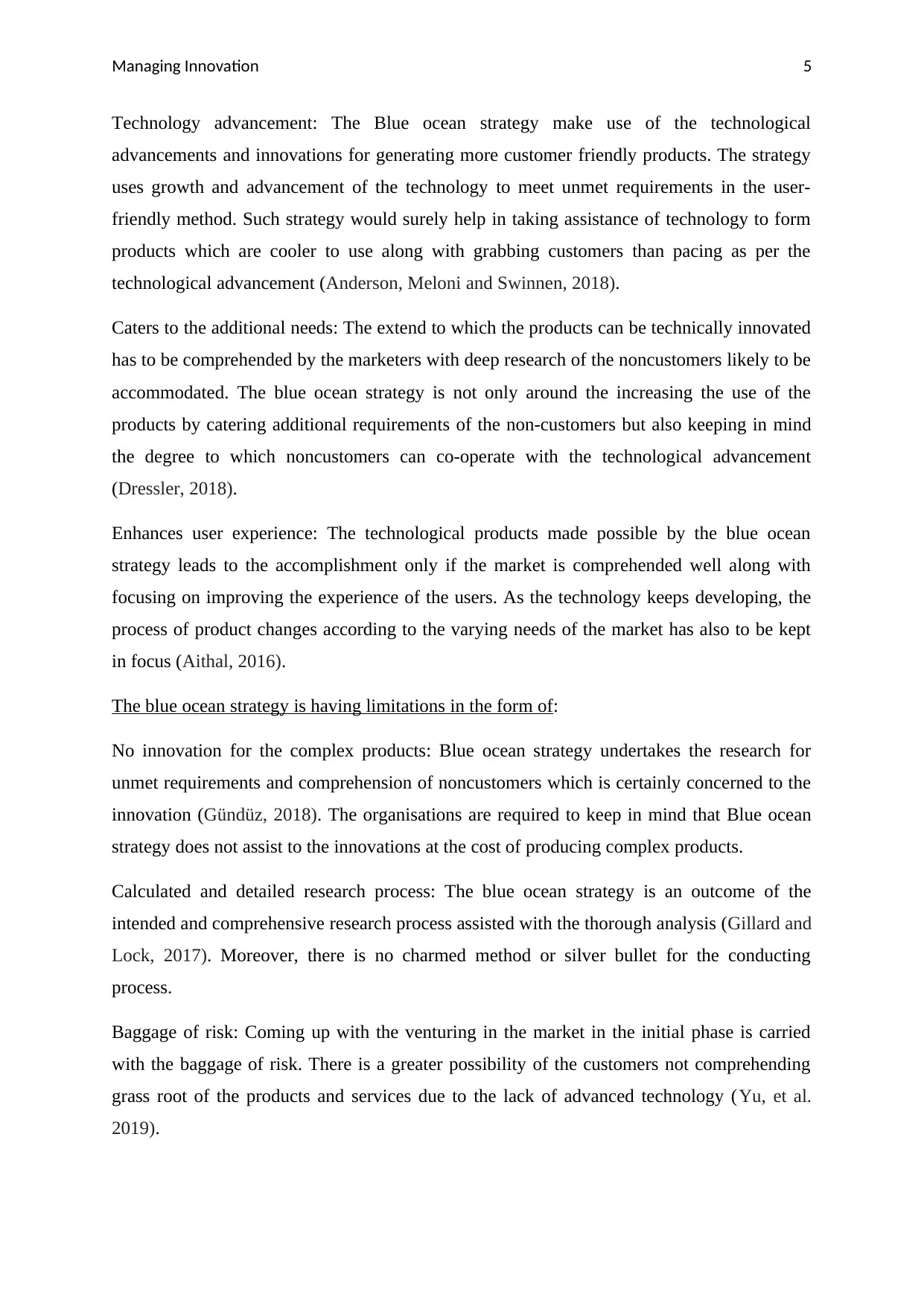
Managing Innovation 5
Technology advancement: The Blue ocean strategy make use of the technological
advancements and innovations for generating more customer friendly products. The strategy
uses growth and advancement of the technology to meet unmet requirements in the user-
friendly method. Such strategy would surely help in taking assistance of technology to form
products which are cooler to use along with grabbing customers than pacing as per the
technological advancement (Anderson, Meloni and Swinnen, 2018).
Caters to the additional needs: The extend to which the products can be technically innovated
has to be comprehended by the marketers with deep research of the noncustomers likely to be
accommodated. The blue ocean strategy is not only around the increasing the use of the
products by catering additional requirements of the non-customers but also keeping in mind
the degree to which noncustomers can co-operate with the technological advancement
(Dressler, 2018).
Enhances user experience: The technological products made possible by the blue ocean
strategy leads to the accomplishment only if the market is comprehended well along with
focusing on improving the experience of the users. As the technology keeps developing, the
process of product changes according to the varying needs of the market has also to be kept
in focus (Aithal, 2016).
The blue ocean strategy is having limitations in the form of:
No innovation for the complex products: Blue ocean strategy undertakes the research for
unmet requirements and comprehension of noncustomers which is certainly concerned to the
innovation (Gündüz, 2018). The organisations are required to keep in mind that Blue ocean
strategy does not assist to the innovations at the cost of producing complex products.
Calculated and detailed research process: The blue ocean strategy is an outcome of the
intended and comprehensive research process assisted with the thorough analysis (Gillard and
Lock, 2017). Moreover, there is no charmed method or silver bullet for the conducting
process.
Baggage of risk: Coming up with the venturing in the market in the initial phase is carried
with the baggage of risk. There is a greater possibility of the customers not comprehending
grass root of the products and services due to the lack of advanced technology (Yu, et al.
2019).
Technology advancement: The Blue ocean strategy make use of the technological
advancements and innovations for generating more customer friendly products. The strategy
uses growth and advancement of the technology to meet unmet requirements in the user-
friendly method. Such strategy would surely help in taking assistance of technology to form
products which are cooler to use along with grabbing customers than pacing as per the
technological advancement (Anderson, Meloni and Swinnen, 2018).
Caters to the additional needs: The extend to which the products can be technically innovated
has to be comprehended by the marketers with deep research of the noncustomers likely to be
accommodated. The blue ocean strategy is not only around the increasing the use of the
products by catering additional requirements of the non-customers but also keeping in mind
the degree to which noncustomers can co-operate with the technological advancement
(Dressler, 2018).
Enhances user experience: The technological products made possible by the blue ocean
strategy leads to the accomplishment only if the market is comprehended well along with
focusing on improving the experience of the users. As the technology keeps developing, the
process of product changes according to the varying needs of the market has also to be kept
in focus (Aithal, 2016).
The blue ocean strategy is having limitations in the form of:
No innovation for the complex products: Blue ocean strategy undertakes the research for
unmet requirements and comprehension of noncustomers which is certainly concerned to the
innovation (Gündüz, 2018). The organisations are required to keep in mind that Blue ocean
strategy does not assist to the innovations at the cost of producing complex products.
Calculated and detailed research process: The blue ocean strategy is an outcome of the
intended and comprehensive research process assisted with the thorough analysis (Gillard and
Lock, 2017). Moreover, there is no charmed method or silver bullet for the conducting
process.
Baggage of risk: Coming up with the venturing in the market in the initial phase is carried
with the baggage of risk. There is a greater possibility of the customers not comprehending
grass root of the products and services due to the lack of advanced technology (Yu, et al.
2019).
⊘ This is a preview!⊘
Do you want full access?
Subscribe today to unlock all pages.

Trusted by 1+ million students worldwide
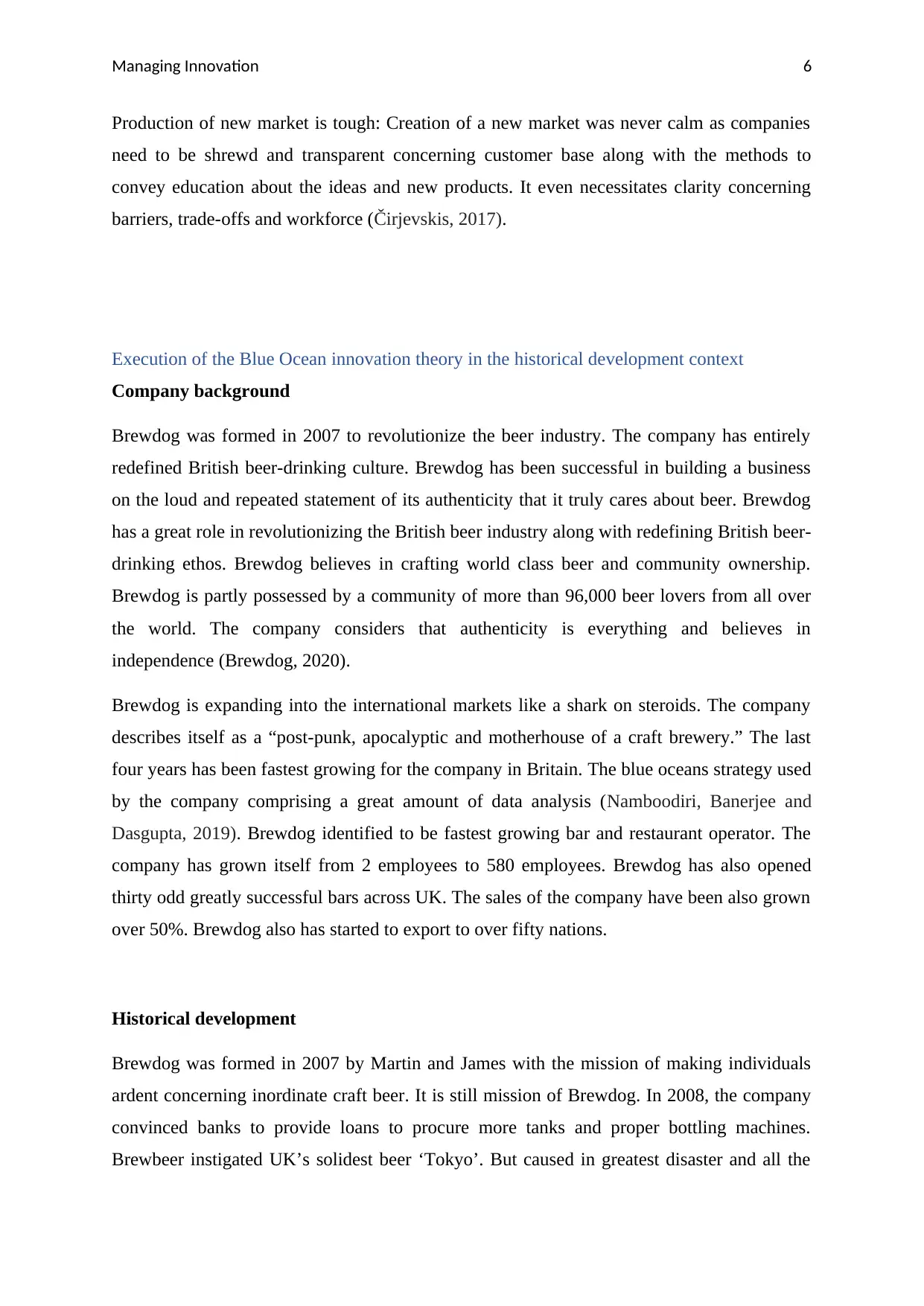
Managing Innovation 6
Production of new market is tough: Creation of a new market was never calm as companies
need to be shrewd and transparent concerning customer base along with the methods to
convey education about the ideas and new products. It even necessitates clarity concerning
barriers, trade-offs and workforce (Čirjevskis, 2017).
Execution of the Blue Ocean innovation theory in the historical development context
Company background
Brewdog was formed in 2007 to revolutionize the beer industry. The company has entirely
redefined British beer-drinking culture. Brewdog has been successful in building a business
on the loud and repeated statement of its authenticity that it truly cares about beer. Brewdog
has a great role in revolutionizing the British beer industry along with redefining British beer-
drinking ethos. Brewdog believes in crafting world class beer and community ownership.
Brewdog is partly possessed by a community of more than 96,000 beer lovers from all over
the world. The company considers that authenticity is everything and believes in
independence (Brewdog, 2020).
Brewdog is expanding into the international markets like a shark on steroids. The company
describes itself as a “post-punk, apocalyptic and motherhouse of a craft brewery.” The last
four years has been fastest growing for the company in Britain. The blue oceans strategy used
by the company comprising a great amount of data analysis (Namboodiri, Banerjee and
Dasgupta, 2019). Brewdog identified to be fastest growing bar and restaurant operator. The
company has grown itself from 2 employees to 580 employees. Brewdog has also opened
thirty odd greatly successful bars across UK. The sales of the company have been also grown
over 50%. Brewdog also has started to export to over fifty nations.
Historical development
Brewdog was formed in 2007 by Martin and James with the mission of making individuals
ardent concerning inordinate craft beer. It is still mission of Brewdog. In 2008, the company
convinced banks to provide loans to procure more tanks and proper bottling machines.
Brewbeer instigated UK’s solidest beer ‘Tokyo’. But caused in greatest disaster and all the
Production of new market is tough: Creation of a new market was never calm as companies
need to be shrewd and transparent concerning customer base along with the methods to
convey education about the ideas and new products. It even necessitates clarity concerning
barriers, trade-offs and workforce (Čirjevskis, 2017).
Execution of the Blue Ocean innovation theory in the historical development context
Company background
Brewdog was formed in 2007 to revolutionize the beer industry. The company has entirely
redefined British beer-drinking culture. Brewdog has been successful in building a business
on the loud and repeated statement of its authenticity that it truly cares about beer. Brewdog
has a great role in revolutionizing the British beer industry along with redefining British beer-
drinking ethos. Brewdog believes in crafting world class beer and community ownership.
Brewdog is partly possessed by a community of more than 96,000 beer lovers from all over
the world. The company considers that authenticity is everything and believes in
independence (Brewdog, 2020).
Brewdog is expanding into the international markets like a shark on steroids. The company
describes itself as a “post-punk, apocalyptic and motherhouse of a craft brewery.” The last
four years has been fastest growing for the company in Britain. The blue oceans strategy used
by the company comprising a great amount of data analysis (Namboodiri, Banerjee and
Dasgupta, 2019). Brewdog identified to be fastest growing bar and restaurant operator. The
company has grown itself from 2 employees to 580 employees. Brewdog has also opened
thirty odd greatly successful bars across UK. The sales of the company have been also grown
over 50%. Brewdog also has started to export to over fifty nations.
Historical development
Brewdog was formed in 2007 by Martin and James with the mission of making individuals
ardent concerning inordinate craft beer. It is still mission of Brewdog. In 2008, the company
convinced banks to provide loans to procure more tanks and proper bottling machines.
Brewbeer instigated UK’s solidest beer ‘Tokyo’. But caused in greatest disaster and all the
Paraphrase This Document
Need a fresh take? Get an instant paraphrase of this document with our AI Paraphraser
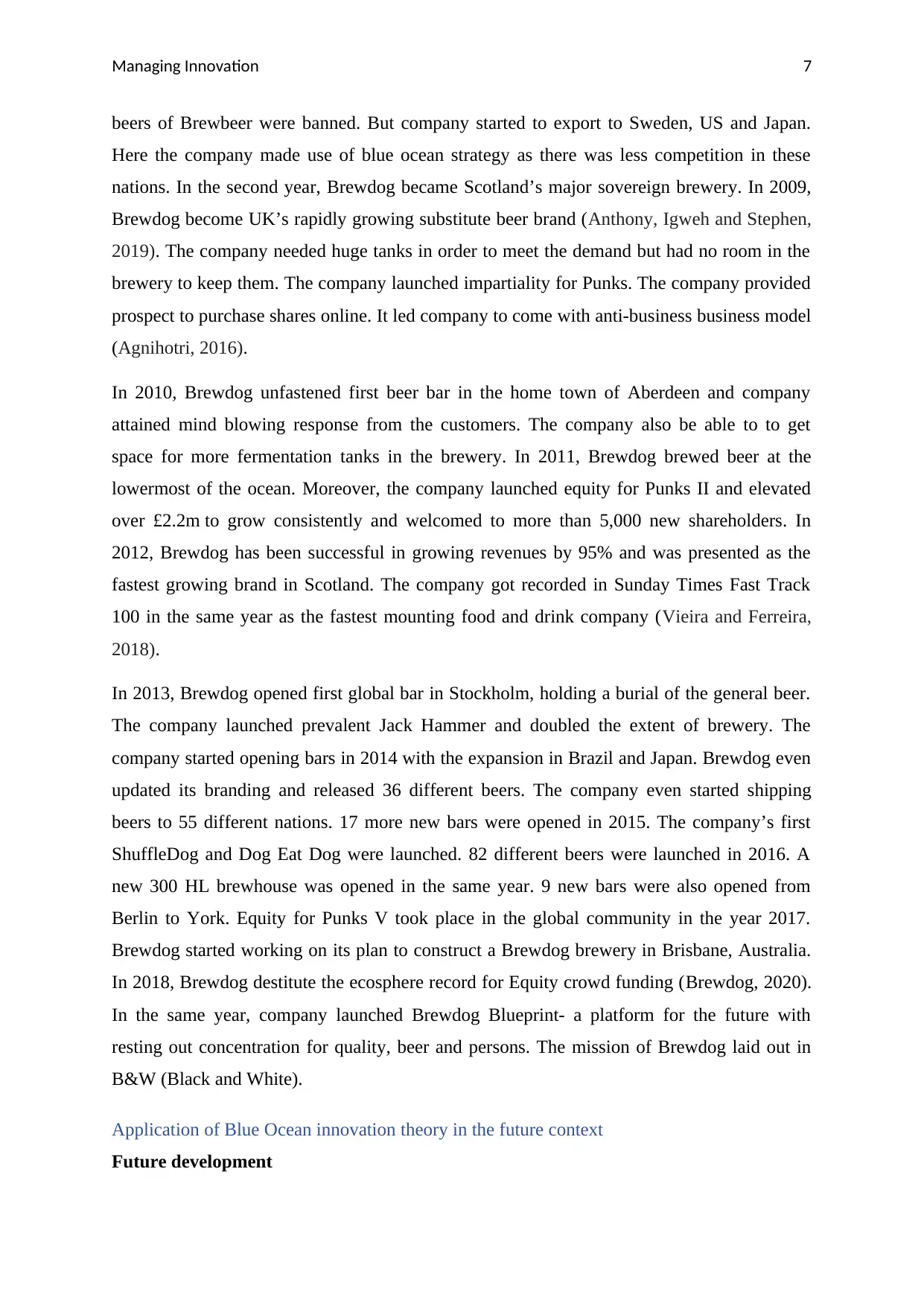
Managing Innovation 7
beers of Brewbeer were banned. But company started to export to Sweden, US and Japan.
Here the company made use of blue ocean strategy as there was less competition in these
nations. In the second year, Brewdog became Scotland’s major sovereign brewery. In 2009,
Brewdog become UK’s rapidly growing substitute beer brand (Anthony, Igweh and Stephen,
2019). The company needed huge tanks in order to meet the demand but had no room in the
brewery to keep them. The company launched impartiality for Punks. The company provided
prospect to purchase shares online. It led company to come with anti-business business model
(Agnihotri, 2016).
In 2010, Brewdog unfastened first beer bar in the home town of Aberdeen and company
attained mind blowing response from the customers. The company also be able to to get
space for more fermentation tanks in the brewery. In 2011, Brewdog brewed beer at the
lowermost of the ocean. Moreover, the company launched equity for Punks II and elevated
over £2.2m to grow consistently and welcomed to more than 5,000 new shareholders. In
2012, Brewdog has been successful in growing revenues by 95% and was presented as the
fastest growing brand in Scotland. The company got recorded in Sunday Times Fast Track
100 in the same year as the fastest mounting food and drink company (Vieira and Ferreira,
2018).
In 2013, Brewdog opened first global bar in Stockholm, holding a burial of the general beer.
The company launched prevalent Jack Hammer and doubled the extent of brewery. The
company started opening bars in 2014 with the expansion in Brazil and Japan. Brewdog even
updated its branding and released 36 different beers. The company even started shipping
beers to 55 different nations. 17 more new bars were opened in 2015. The company’s first
ShuffleDog and Dog Eat Dog were launched. 82 different beers were launched in 2016. A
new 300 HL brewhouse was opened in the same year. 9 new bars were also opened from
Berlin to York. Equity for Punks V took place in the global community in the year 2017.
Brewdog started working on its plan to construct a Brewdog brewery in Brisbane, Australia.
In 2018, Brewdog destitute the ecosphere record for Equity crowd funding (Brewdog, 2020).
In the same year, company launched Brewdog Blueprint- a platform for the future with
resting out concentration for quality, beer and persons. The mission of Brewdog laid out in
B&W (Black and White).
Application of Blue Ocean innovation theory in the future context
Future development
beers of Brewbeer were banned. But company started to export to Sweden, US and Japan.
Here the company made use of blue ocean strategy as there was less competition in these
nations. In the second year, Brewdog became Scotland’s major sovereign brewery. In 2009,
Brewdog become UK’s rapidly growing substitute beer brand (Anthony, Igweh and Stephen,
2019). The company needed huge tanks in order to meet the demand but had no room in the
brewery to keep them. The company launched impartiality for Punks. The company provided
prospect to purchase shares online. It led company to come with anti-business business model
(Agnihotri, 2016).
In 2010, Brewdog unfastened first beer bar in the home town of Aberdeen and company
attained mind blowing response from the customers. The company also be able to to get
space for more fermentation tanks in the brewery. In 2011, Brewdog brewed beer at the
lowermost of the ocean. Moreover, the company launched equity for Punks II and elevated
over £2.2m to grow consistently and welcomed to more than 5,000 new shareholders. In
2012, Brewdog has been successful in growing revenues by 95% and was presented as the
fastest growing brand in Scotland. The company got recorded in Sunday Times Fast Track
100 in the same year as the fastest mounting food and drink company (Vieira and Ferreira,
2018).
In 2013, Brewdog opened first global bar in Stockholm, holding a burial of the general beer.
The company launched prevalent Jack Hammer and doubled the extent of brewery. The
company started opening bars in 2014 with the expansion in Brazil and Japan. Brewdog even
updated its branding and released 36 different beers. The company even started shipping
beers to 55 different nations. 17 more new bars were opened in 2015. The company’s first
ShuffleDog and Dog Eat Dog were launched. 82 different beers were launched in 2016. A
new 300 HL brewhouse was opened in the same year. 9 new bars were also opened from
Berlin to York. Equity for Punks V took place in the global community in the year 2017.
Brewdog started working on its plan to construct a Brewdog brewery in Brisbane, Australia.
In 2018, Brewdog destitute the ecosphere record for Equity crowd funding (Brewdog, 2020).
In the same year, company launched Brewdog Blueprint- a platform for the future with
resting out concentration for quality, beer and persons. The mission of Brewdog laid out in
B&W (Black and White).
Application of Blue Ocean innovation theory in the future context
Future development
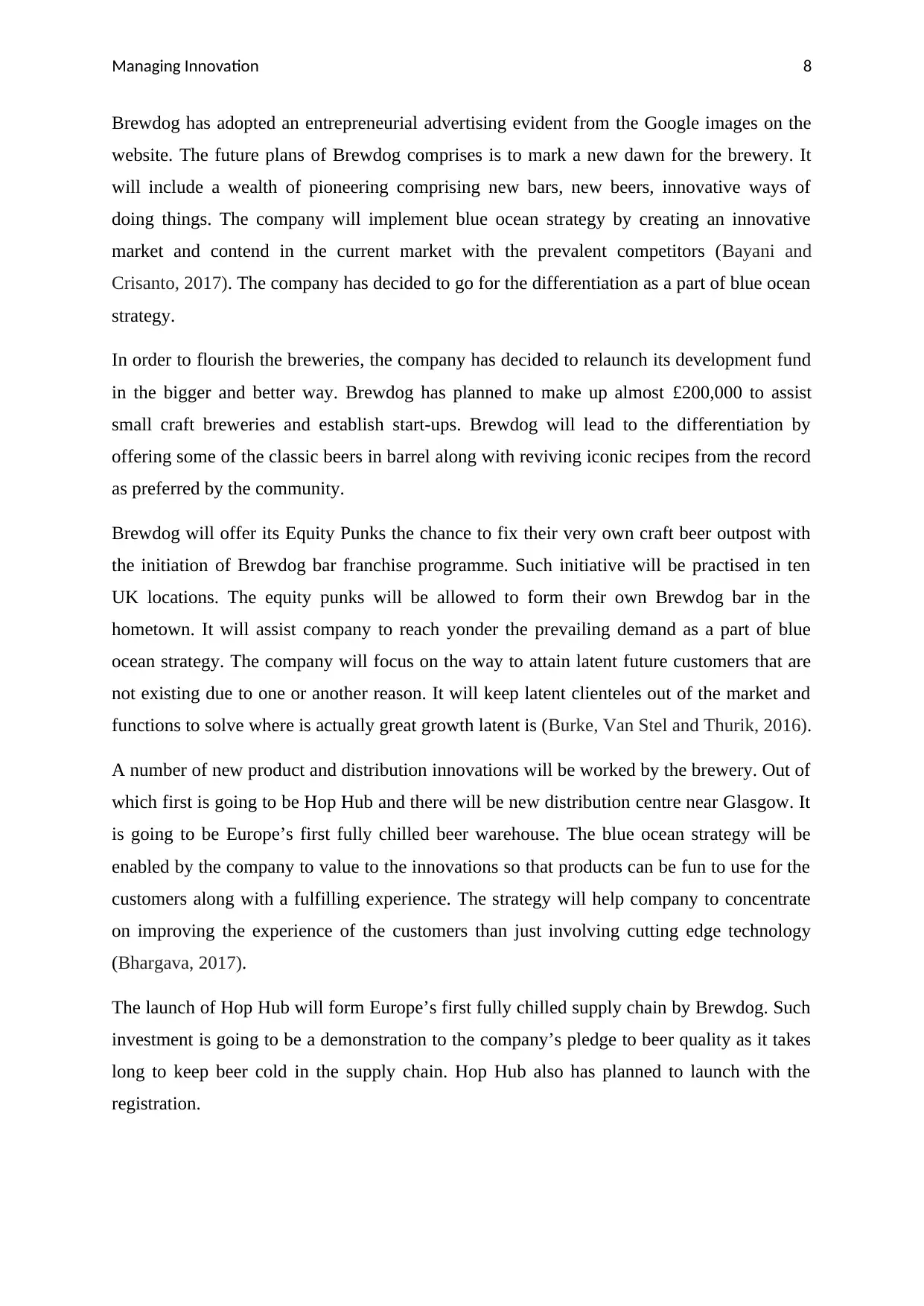
Managing Innovation 8
Brewdog has adopted an entrepreneurial advertising evident from the Google images on the
website. The future plans of Brewdog comprises is to mark a new dawn for the brewery. It
will include a wealth of pioneering comprising new bars, new beers, innovative ways of
doing things. The company will implement blue ocean strategy by creating an innovative
market and contend in the current market with the prevalent competitors (Bayani and
Crisanto, 2017). The company has decided to go for the differentiation as a part of blue ocean
strategy.
In order to flourish the breweries, the company has decided to relaunch its development fund
in the bigger and better way. Brewdog has planned to make up almost £200,000 to assist
small craft breweries and establish start-ups. Brewdog will lead to the differentiation by
offering some of the classic beers in barrel along with reviving iconic recipes from the record
as preferred by the community.
Brewdog will offer its Equity Punks the chance to fix their very own craft beer outpost with
the initiation of Brewdog bar franchise programme. Such initiative will be practised in ten
UK locations. The equity punks will be allowed to form their own Brewdog bar in the
hometown. It will assist company to reach yonder the prevailing demand as a part of blue
ocean strategy. The company will focus on the way to attain latent future customers that are
not existing due to one or another reason. It will keep latent clienteles out of the market and
functions to solve where is actually great growth latent is (Burke, Van Stel and Thurik, 2016).
A number of new product and distribution innovations will be worked by the brewery. Out of
which first is going to be Hop Hub and there will be new distribution centre near Glasgow. It
is going to be Europe’s first fully chilled beer warehouse. The blue ocean strategy will be
enabled by the company to value to the innovations so that products can be fun to use for the
customers along with a fulfilling experience. The strategy will help company to concentrate
on improving the experience of the customers than just involving cutting edge technology
(Bhargava, 2017).
The launch of Hop Hub will form Europe’s first fully chilled supply chain by Brewdog. Such
investment is going to be a demonstration to the company’s pledge to beer quality as it takes
long to keep beer cold in the supply chain. Hop Hub also has planned to launch with the
registration.
Brewdog has adopted an entrepreneurial advertising evident from the Google images on the
website. The future plans of Brewdog comprises is to mark a new dawn for the brewery. It
will include a wealth of pioneering comprising new bars, new beers, innovative ways of
doing things. The company will implement blue ocean strategy by creating an innovative
market and contend in the current market with the prevalent competitors (Bayani and
Crisanto, 2017). The company has decided to go for the differentiation as a part of blue ocean
strategy.
In order to flourish the breweries, the company has decided to relaunch its development fund
in the bigger and better way. Brewdog has planned to make up almost £200,000 to assist
small craft breweries and establish start-ups. Brewdog will lead to the differentiation by
offering some of the classic beers in barrel along with reviving iconic recipes from the record
as preferred by the community.
Brewdog will offer its Equity Punks the chance to fix their very own craft beer outpost with
the initiation of Brewdog bar franchise programme. Such initiative will be practised in ten
UK locations. The equity punks will be allowed to form their own Brewdog bar in the
hometown. It will assist company to reach yonder the prevailing demand as a part of blue
ocean strategy. The company will focus on the way to attain latent future customers that are
not existing due to one or another reason. It will keep latent clienteles out of the market and
functions to solve where is actually great growth latent is (Burke, Van Stel and Thurik, 2016).
A number of new product and distribution innovations will be worked by the brewery. Out of
which first is going to be Hop Hub and there will be new distribution centre near Glasgow. It
is going to be Europe’s first fully chilled beer warehouse. The blue ocean strategy will be
enabled by the company to value to the innovations so that products can be fun to use for the
customers along with a fulfilling experience. The strategy will help company to concentrate
on improving the experience of the customers than just involving cutting edge technology
(Bhargava, 2017).
The launch of Hop Hub will form Europe’s first fully chilled supply chain by Brewdog. Such
investment is going to be a demonstration to the company’s pledge to beer quality as it takes
long to keep beer cold in the supply chain. Hop Hub also has planned to launch with the
registration.
⊘ This is a preview!⊘
Do you want full access?
Subscribe today to unlock all pages.

Trusted by 1+ million students worldwide
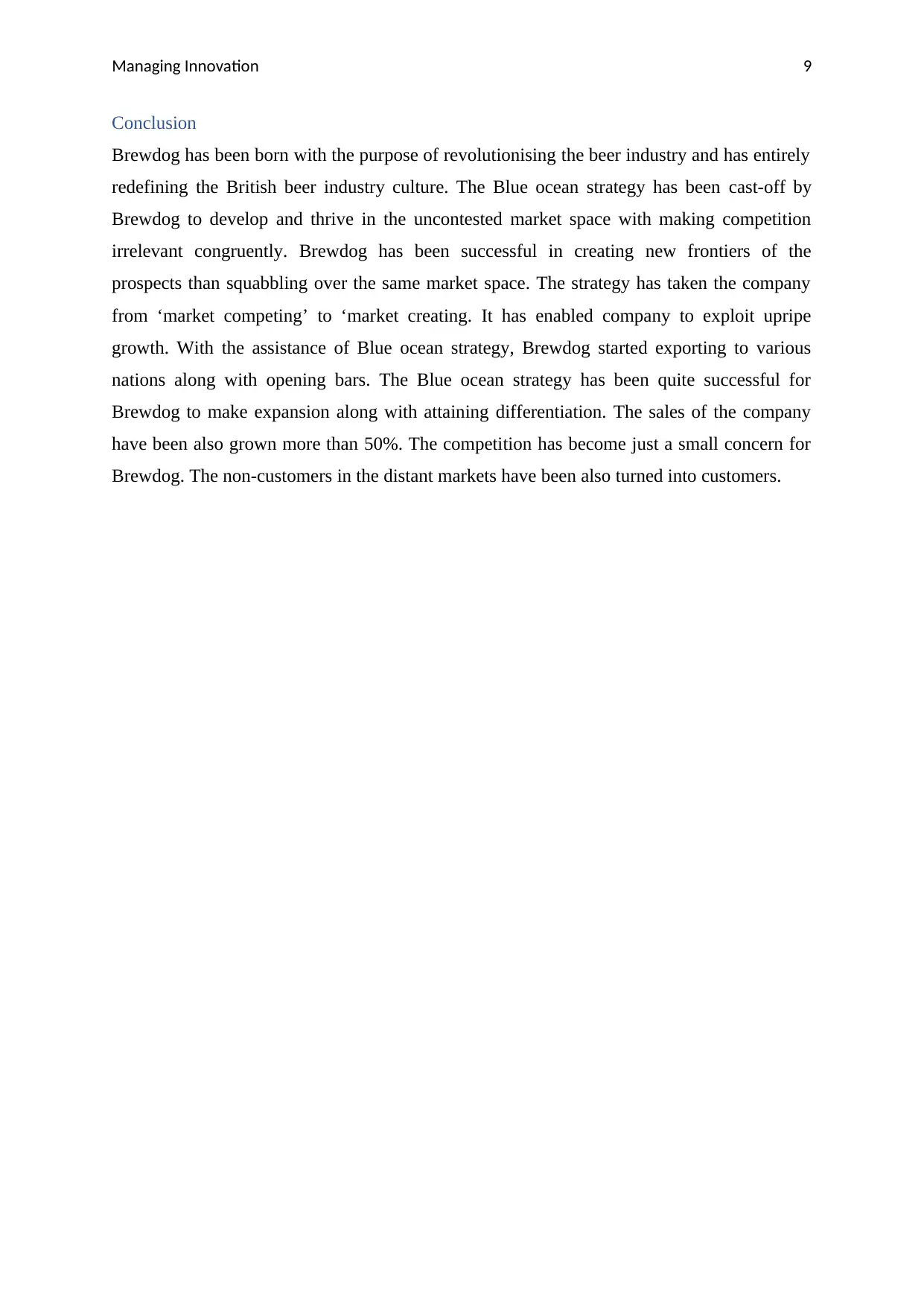
Managing Innovation 9
Conclusion
Brewdog has been born with the purpose of revolutionising the beer industry and has entirely
redefining the British beer industry culture. The Blue ocean strategy has been cast-off by
Brewdog to develop and thrive in the uncontested market space with making competition
irrelevant congruently. Brewdog has been successful in creating new frontiers of the
prospects than squabbling over the same market space. The strategy has taken the company
from ‘market competing’ to ‘market creating. It has enabled company to exploit upripe
growth. With the assistance of Blue ocean strategy, Brewdog started exporting to various
nations along with opening bars. The Blue ocean strategy has been quite successful for
Brewdog to make expansion along with attaining differentiation. The sales of the company
have been also grown more than 50%. The competition has become just a small concern for
Brewdog. The non-customers in the distant markets have been also turned into customers.
Conclusion
Brewdog has been born with the purpose of revolutionising the beer industry and has entirely
redefining the British beer industry culture. The Blue ocean strategy has been cast-off by
Brewdog to develop and thrive in the uncontested market space with making competition
irrelevant congruently. Brewdog has been successful in creating new frontiers of the
prospects than squabbling over the same market space. The strategy has taken the company
from ‘market competing’ to ‘market creating. It has enabled company to exploit upripe
growth. With the assistance of Blue ocean strategy, Brewdog started exporting to various
nations along with opening bars. The Blue ocean strategy has been quite successful for
Brewdog to make expansion along with attaining differentiation. The sales of the company
have been also grown more than 50%. The competition has become just a small concern for
Brewdog. The non-customers in the distant markets have been also turned into customers.
Paraphrase This Document
Need a fresh take? Get an instant paraphrase of this document with our AI Paraphraser
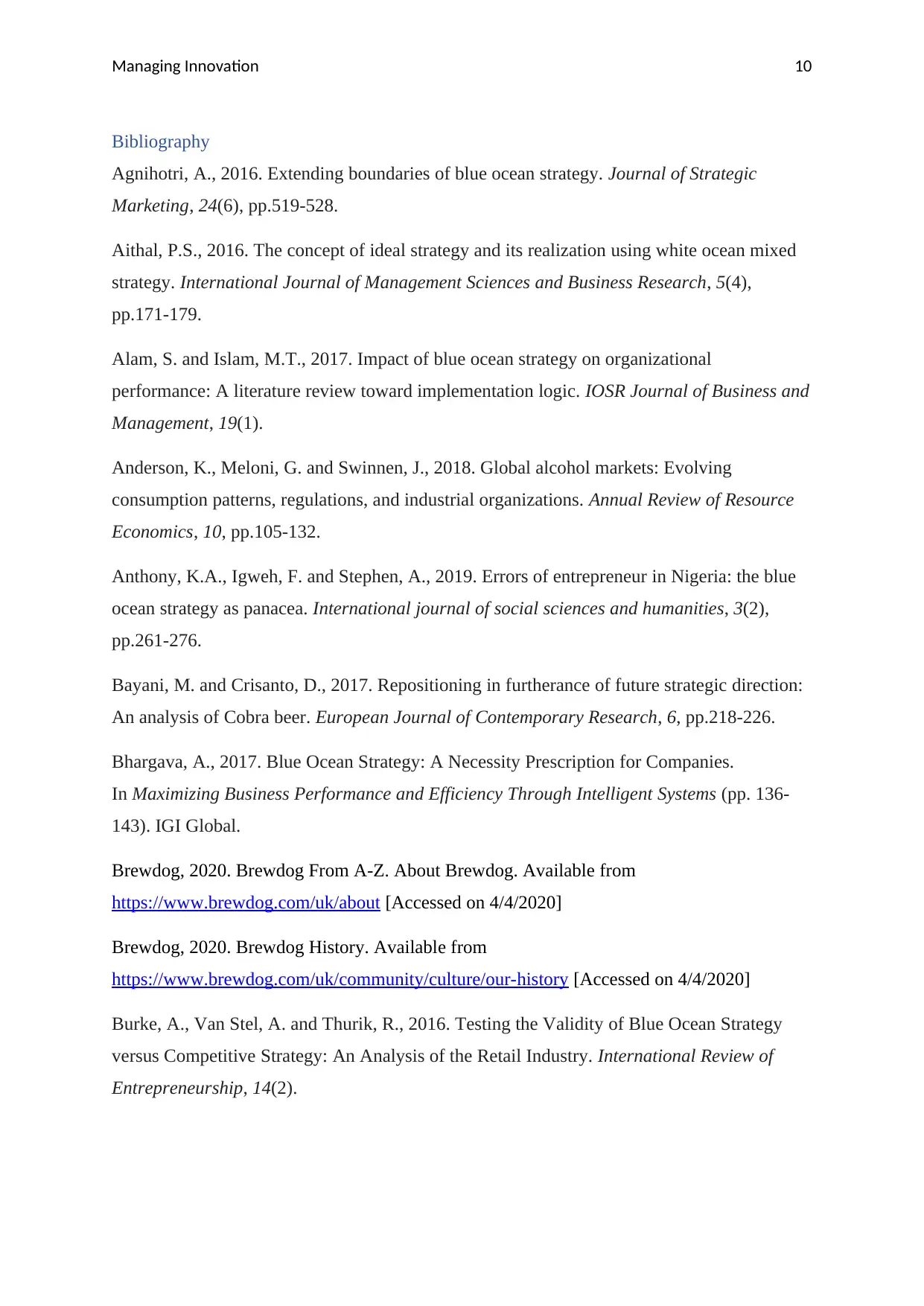
Managing Innovation 10
Bibliography
Agnihotri, A., 2016. Extending boundaries of blue ocean strategy. Journal of Strategic
Marketing, 24(6), pp.519-528.
Aithal, P.S., 2016. The concept of ideal strategy and its realization using white ocean mixed
strategy. International Journal of Management Sciences and Business Research, 5(4),
pp.171-179.
Alam, S. and Islam, M.T., 2017. Impact of blue ocean strategy on organizational
performance: A literature review toward implementation logic. IOSR Journal of Business and
Management, 19(1).
Anderson, K., Meloni, G. and Swinnen, J., 2018. Global alcohol markets: Evolving
consumption patterns, regulations, and industrial organizations. Annual Review of Resource
Economics, 10, pp.105-132.
Anthony, K.A., Igweh, F. and Stephen, A., 2019. Errors of entrepreneur in Nigeria: the blue
ocean strategy as panacea. International journal of social sciences and humanities, 3(2),
pp.261-276.
Bayani, M. and Crisanto, D., 2017. Repositioning in furtherance of future strategic direction:
An analysis of Cobra beer. European Journal of Contemporary Research, 6, pp.218-226.
Bhargava, A., 2017. Blue Ocean Strategy: A Necessity Prescription for Companies.
In Maximizing Business Performance and Efficiency Through Intelligent Systems (pp. 136-
143). IGI Global.
Brewdog, 2020. Brewdog From A-Z. About Brewdog. Available from
https://www.brewdog.com/uk/about [Accessed on 4/4/2020]
Brewdog, 2020. Brewdog History. Available from
https://www.brewdog.com/uk/community/culture/our-history [Accessed on 4/4/2020]
Burke, A., Van Stel, A. and Thurik, R., 2016. Testing the Validity of Blue Ocean Strategy
versus Competitive Strategy: An Analysis of the Retail Industry. International Review of
Entrepreneurship, 14(2).
Bibliography
Agnihotri, A., 2016. Extending boundaries of blue ocean strategy. Journal of Strategic
Marketing, 24(6), pp.519-528.
Aithal, P.S., 2016. The concept of ideal strategy and its realization using white ocean mixed
strategy. International Journal of Management Sciences and Business Research, 5(4),
pp.171-179.
Alam, S. and Islam, M.T., 2017. Impact of blue ocean strategy on organizational
performance: A literature review toward implementation logic. IOSR Journal of Business and
Management, 19(1).
Anderson, K., Meloni, G. and Swinnen, J., 2018. Global alcohol markets: Evolving
consumption patterns, regulations, and industrial organizations. Annual Review of Resource
Economics, 10, pp.105-132.
Anthony, K.A., Igweh, F. and Stephen, A., 2019. Errors of entrepreneur in Nigeria: the blue
ocean strategy as panacea. International journal of social sciences and humanities, 3(2),
pp.261-276.
Bayani, M. and Crisanto, D., 2017. Repositioning in furtherance of future strategic direction:
An analysis of Cobra beer. European Journal of Contemporary Research, 6, pp.218-226.
Bhargava, A., 2017. Blue Ocean Strategy: A Necessity Prescription for Companies.
In Maximizing Business Performance and Efficiency Through Intelligent Systems (pp. 136-
143). IGI Global.
Brewdog, 2020. Brewdog From A-Z. About Brewdog. Available from
https://www.brewdog.com/uk/about [Accessed on 4/4/2020]
Brewdog, 2020. Brewdog History. Available from
https://www.brewdog.com/uk/community/culture/our-history [Accessed on 4/4/2020]
Burke, A., Van Stel, A. and Thurik, R., 2016. Testing the Validity of Blue Ocean Strategy
versus Competitive Strategy: An Analysis of the Retail Industry. International Review of
Entrepreneurship, 14(2).
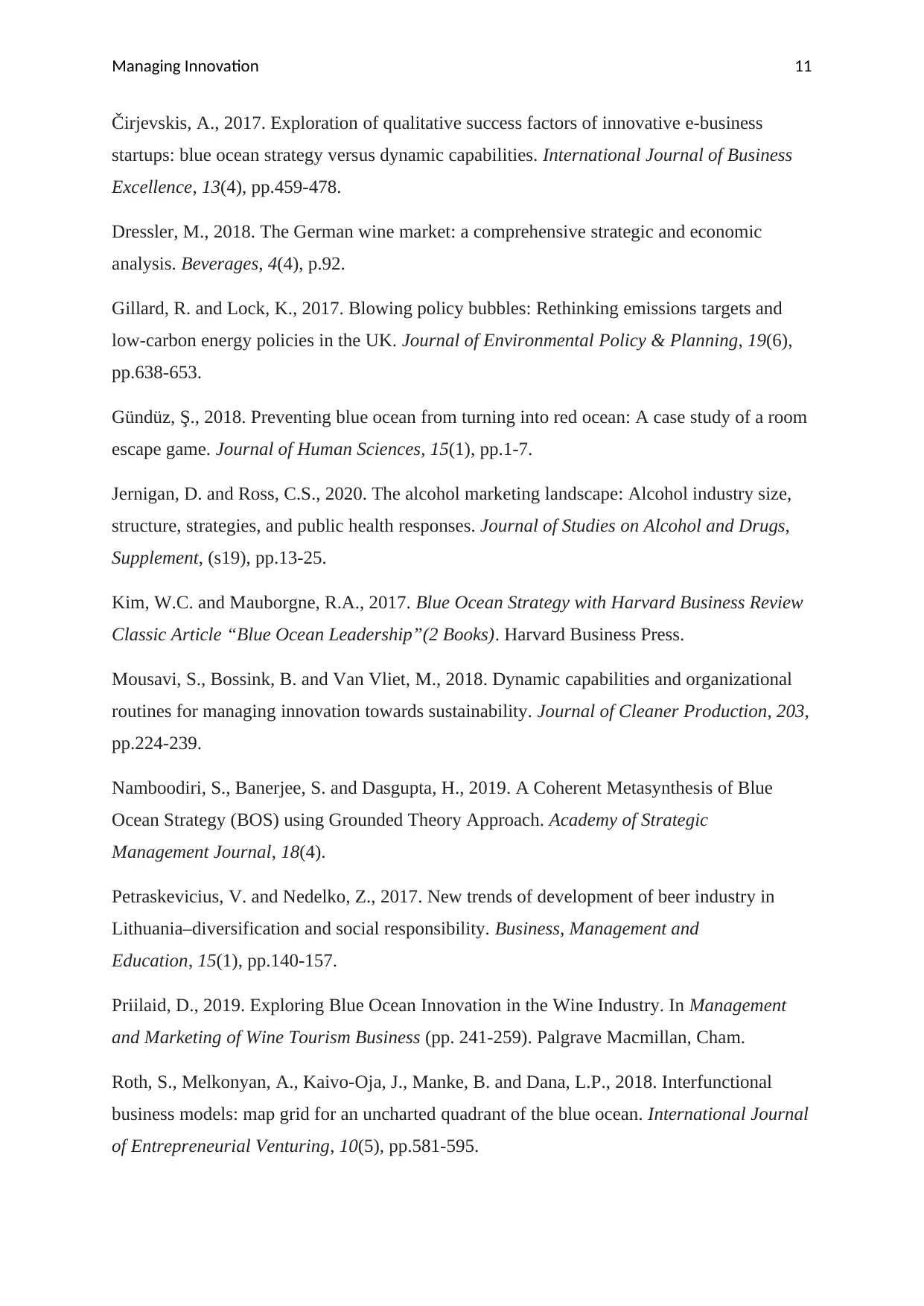
Managing Innovation 11
Čirjevskis, A., 2017. Exploration of qualitative success factors of innovative e-business
startups: blue ocean strategy versus dynamic capabilities. International Journal of Business
Excellence, 13(4), pp.459-478.
Dressler, M., 2018. The German wine market: a comprehensive strategic and economic
analysis. Beverages, 4(4), p.92.
Gillard, R. and Lock, K., 2017. Blowing policy bubbles: Rethinking emissions targets and
low-carbon energy policies in the UK. Journal of Environmental Policy & Planning, 19(6),
pp.638-653.
Gündüz, Ş., 2018. Preventing blue ocean from turning into red ocean: A case study of a room
escape game. Journal of Human Sciences, 15(1), pp.1-7.
Jernigan, D. and Ross, C.S., 2020. The alcohol marketing landscape: Alcohol industry size,
structure, strategies, and public health responses. Journal of Studies on Alcohol and Drugs,
Supplement, (s19), pp.13-25.
Kim, W.C. and Mauborgne, R.A., 2017. Blue Ocean Strategy with Harvard Business Review
Classic Article “Blue Ocean Leadership”(2 Books). Harvard Business Press.
Mousavi, S., Bossink, B. and Van Vliet, M., 2018. Dynamic capabilities and organizational
routines for managing innovation towards sustainability. Journal of Cleaner Production, 203,
pp.224-239.
Namboodiri, S., Banerjee, S. and Dasgupta, H., 2019. A Coherent Metasynthesis of Blue
Ocean Strategy (BOS) using Grounded Theory Approach. Academy of Strategic
Management Journal, 18(4).
Petraskevicius, V. and Nedelko, Z., 2017. New trends of development of beer industry in
Lithuania–diversification and social responsibility. Business, Management and
Education, 15(1), pp.140-157.
Priilaid, D., 2019. Exploring Blue Ocean Innovation in the Wine Industry. In Management
and Marketing of Wine Tourism Business (pp. 241-259). Palgrave Macmillan, Cham.
Roth, S., Melkonyan, A., Kaivo-Oja, J., Manke, B. and Dana, L.P., 2018. Interfunctional
business models: map grid for an uncharted quadrant of the blue ocean. International Journal
of Entrepreneurial Venturing, 10(5), pp.581-595.
Čirjevskis, A., 2017. Exploration of qualitative success factors of innovative e-business
startups: blue ocean strategy versus dynamic capabilities. International Journal of Business
Excellence, 13(4), pp.459-478.
Dressler, M., 2018. The German wine market: a comprehensive strategic and economic
analysis. Beverages, 4(4), p.92.
Gillard, R. and Lock, K., 2017. Blowing policy bubbles: Rethinking emissions targets and
low-carbon energy policies in the UK. Journal of Environmental Policy & Planning, 19(6),
pp.638-653.
Gündüz, Ş., 2018. Preventing blue ocean from turning into red ocean: A case study of a room
escape game. Journal of Human Sciences, 15(1), pp.1-7.
Jernigan, D. and Ross, C.S., 2020. The alcohol marketing landscape: Alcohol industry size,
structure, strategies, and public health responses. Journal of Studies on Alcohol and Drugs,
Supplement, (s19), pp.13-25.
Kim, W.C. and Mauborgne, R.A., 2017. Blue Ocean Strategy with Harvard Business Review
Classic Article “Blue Ocean Leadership”(2 Books). Harvard Business Press.
Mousavi, S., Bossink, B. and Van Vliet, M., 2018. Dynamic capabilities and organizational
routines for managing innovation towards sustainability. Journal of Cleaner Production, 203,
pp.224-239.
Namboodiri, S., Banerjee, S. and Dasgupta, H., 2019. A Coherent Metasynthesis of Blue
Ocean Strategy (BOS) using Grounded Theory Approach. Academy of Strategic
Management Journal, 18(4).
Petraskevicius, V. and Nedelko, Z., 2017. New trends of development of beer industry in
Lithuania–diversification and social responsibility. Business, Management and
Education, 15(1), pp.140-157.
Priilaid, D., 2019. Exploring Blue Ocean Innovation in the Wine Industry. In Management
and Marketing of Wine Tourism Business (pp. 241-259). Palgrave Macmillan, Cham.
Roth, S., Melkonyan, A., Kaivo-Oja, J., Manke, B. and Dana, L.P., 2018. Interfunctional
business models: map grid for an uncharted quadrant of the blue ocean. International Journal
of Entrepreneurial Venturing, 10(5), pp.581-595.
⊘ This is a preview!⊘
Do you want full access?
Subscribe today to unlock all pages.

Trusted by 1+ million students worldwide
1 out of 14
Related Documents
Your All-in-One AI-Powered Toolkit for Academic Success.
+13062052269
info@desklib.com
Available 24*7 on WhatsApp / Email
![[object Object]](/_next/static/media/star-bottom.7253800d.svg)
Unlock your academic potential
Copyright © 2020–2025 A2Z Services. All Rights Reserved. Developed and managed by ZUCOL.




